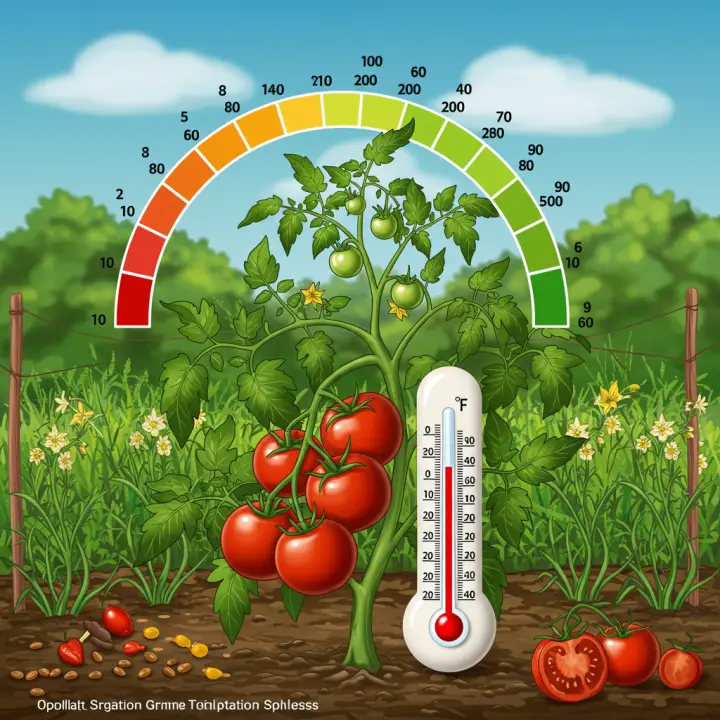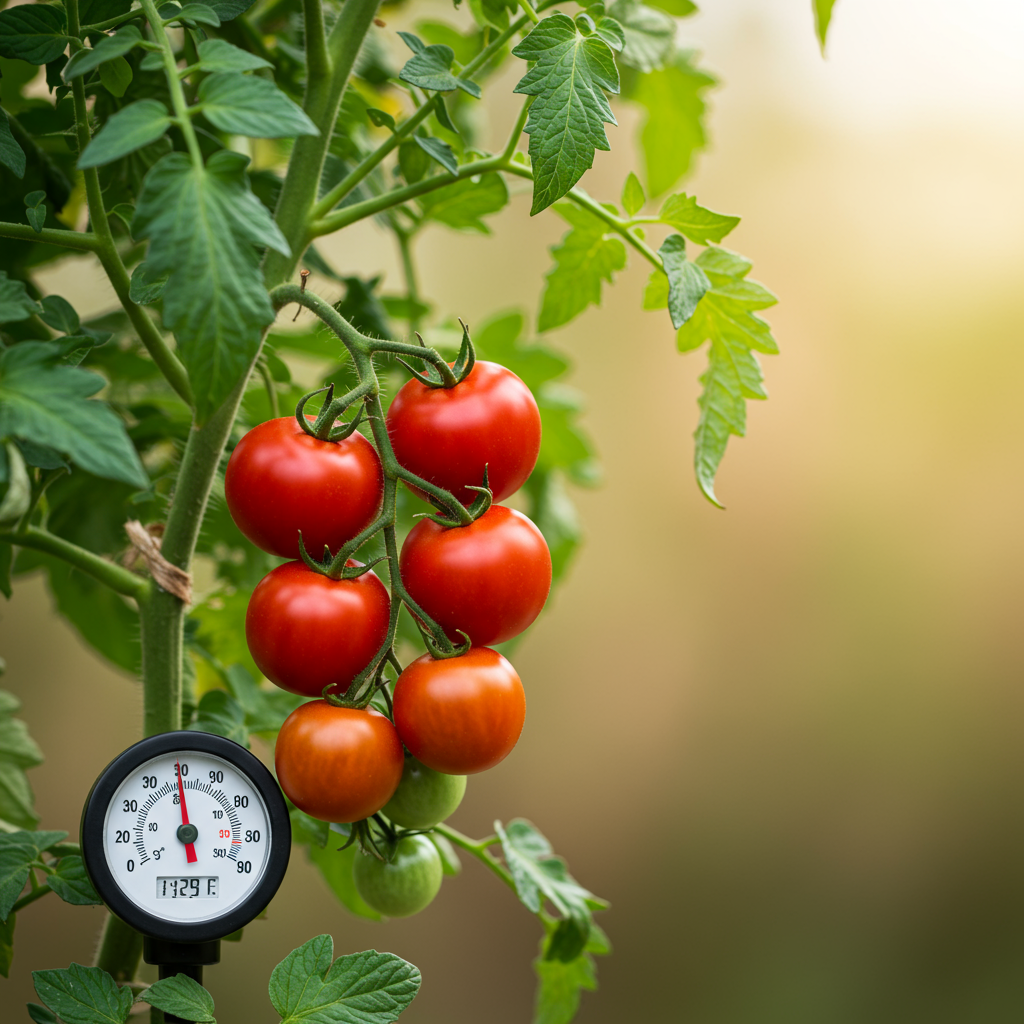Tomato plant temperature is arguably the single most important environmental factor influencing the success of your harvest. More than water, more than fertilizer, and even more than sunlight, temperature dictates every stage of a tomato’s life, from a tiny seed to a heavy, vine-ripened fruit. Get it right, and you’ll be rewarded with vigorous plants and a bounty of delicious tomatoes. Get it wrong, and you’ll face a season of frustration, with stunted growth, blossom drop, and disappointing yields.
Many gardeners focus intensely on soil amendments and watering schedules, treating temperature as an uncontrollable act of nature. But the truth is, you have more control than you think. Understanding the precise needs of your tomato plants allows you to become a proactive gardener, capable of shielding them from extremes and creating a microclimate where they can not only survive but truly thrive.
This ultimate guide will break down everything you need to know. We’ll explore the ideal “Goldilocks zone” for tomatoes, dive deep into the dangers of both cold and heat, and provide actionable, practical strategies to manage your garden’s temperature throughout the growing season. By the end, you’ll be equipped to act as your garden’s thermostat, ensuring your tomato plants are always comfortable, healthy, and productive.
Why Temperature is the Master Controller

Before we get into specific numbers, it’s crucial to understand why temperature holds so much power over your tomato plants. It directly governs several key biological processes:
Photosynthesis: This is the process where plants convert sunlight into energy (sugars) to fuel their growth. The enzymes that drive photosynthesis have an optimal temperature range. Too cold, and the process slows to a crawl. Too hot, and the enzymes begin to break down, shutting down energy production.
Respiration: Plants “breathe” just like we do, breaking down sugars to release energy for cellular functions. At night, when there’s no sunlight for photosynthesis, respiration is key. If nights are too warm, the plant respires too quickly, burning through the energy it created during the day, which can lead to lanky, stressed growth.
Pollination and Fruit Set: This is where many gardeners face heartbreak. For a tomato flower to be successfully pollinated and develop into a fruit, its pollen must be viable. Extreme temperatures, especially heat, sterilize the pollen, causing flowers to drop off the plant without setting fruit.
Nutrient and Water Uptake: The roots absorb water and nutrients from the soil. When the soil is too cold, this process becomes incredibly inefficient. You might see purplish leaves on your young plants, a classic sign of a phosphorus deficiency, not because there’s no phosphorus in the soil, but because the cold roots can’t absorb it.
In short, temperature isn’t just about comfort; it’s about function. Your plant’s entire internal machinery is calibrated to operate within a specific thermal range.
The Goldilocks Zone: The Ideal Temperature Range
Tomatoes, being subtropical natives, love warmth but despise extremes. They have a “Goldilocks zone” where all their biological systems function in perfect harmony.
The Ideal Daytime Temperature is between 70°F and 85°F (21°C and 29°C).
Within this range, photosynthesis is at its peak, growth is vigorous, and the plant is efficiently converting sunlight into the building blocks for leaves, stems, and, most importantly, fruit.
The Ideal Nighttime Temperature is between 60°F and 70°F (15°C and 21°C).
This drop in temperature at night is essential. It slows down the plant’s respiration rate, allowing it to conserve the energy it produced during the day. This saved energy is then funneled into robust growth and fruit development. Nights that stay too warm (above 75°F / 24°C) can be just as stressful as scorching days.
Think of this 60-85°F (15-29°C) window as the ultimate goal for your tomato plants. The more time they spend within this range, the healthier and more productive they will be.
The Dangers of Cold: When Temperatures Drop Too Low
While tomatoes dislike intense heat, cold is their most immediate and deadly enemy. Understanding the thresholds is key to protecting your plants, especially in the spring.
The Chilling Zone: 50°F to 60°F (10°C to 15°C)
When temperatures consistently hover in this range, your tomato plants won’t die, but they will suffer.
Stunted Growth: All metabolic processes slow down. The plant hunkers down in survival mode rather than growth mode.
Poor Nutrient Uptake: As mentioned, cold soil severely hampers the roots’ ability to absorb nutrients, particularly phosphorus. This leads to the characteristic purple tint on the leaves and stems.
Flower Drop: Even if the plant manages to produce blossoms, the cold can interfere with pollination, causing them to drop off before they can be fertilized.
The Danger Zone: Below 50°F (10°C)
Sustained temperatures below 50°F will cause significant stress and damage. Young seedlings are especially vulnerable. Growth will stop completely, leaves may yellow and wilt, and the plant’s overall vitality will be compromised, making it more susceptible to disease.
The Kill Zone: 32°F (0°C) and Below
A frost or freeze is a death sentence for an unprotected tomato plant. At 32°F, the water inside the plant’s cells begins to freeze. As the water forms ice crystals, it expands, rupturing and destroying the cell walls. This damage is irreversible. A plant hit by a hard frost will turn dark, limp, and mushy—a heartbreaking sight for any gardener.
The Dangers of Heat: When the Sizzle Becomes a Fizzle
Gardeners in warmer climates are all too familiar with the challenges of summer heatwaves. While tomatoes are sun-lovers, there is a clear upper limit to what they can tolerate.
The Stress Zone: 85°F to 95°F (29°C to 35°C)
As temperatures climb into this range, the plant begins to experience significant stress.
Blossom Drop: This is the most common and frustrating symptom of high heat. The pollen within the tomato flower becomes sticky, non-viable, and unable to properly fertilize the flower’s ovary. The plant, sensing the failure, aborts the flower, which withers and drops off.
Reduced Photosynthesis: To conserve water, the plant closes the tiny pores (stomata) on its leaves. This prevents water loss but also drastically reduces the intake of carbon dioxide, effectively shutting down photosynthesis and halting growth.
Wilting: The plant may lose water through its leaves (transpiration) faster than its roots can absorb it from the soil, leading to wilting during the hottest part of the day.
The Danger Zone: Above 95°F (35°C)
Consistently high temperatures above 95°F are deeply damaging.
Pollination Failure: Pollination comes to a complete halt. You may see a gap in fruit production that corresponds directly to a heatwave a few weeks prior.
Sunscald: The fruit itself can get sunburned. This appears as a white or yellow, papery, and sunken patch on the side of the tomato exposed to the intense sun. The damaged area is prone to secondary infections and rot.
Poor Fruit Quality: Even if fruit does set and ripen, extreme heat can affect quality. It can lead to uneven ripening (green shoulders) and interfere with the development of lycopene, the pigment responsible for the red color and many of the tomato’s health benefits.
A Deeper Look at the Ideal Tomato Plant Temperature by Growth Stage
The “Goldilocks zone” is a great general rule, but the plant’s ideal temperature does shift slightly depending on its stage of life. Optimizing for each stage gives you an expert edge.
1. Seed Germination
For seeds to sprout, they need consistent warmth and moisture. The soil temperature is more important than the air temperature here.
Ideal Soil Temperature: 75°F to 85°F (24°C to 29°C)
At this temperature, you can expect germination in just 5-7 days. Using a seedling heat mat is the most reliable way to achieve this and give your plants a strong, uniform start.
2. Seedling Growth
Once the seedlings have emerged, they benefit from slightly cooler temperatures. This prevents them from becoming “leggy”—tall and weak.
Ideal Air Temperature: 65°F to 75°F (18°C to 24°C)
Providing strong, direct light (from a south-facing window or grow lights) is also critical during this stage to encourage stocky, robust growth.
3. Flowering and Fruiting
This is when the classic Goldilocks zone is most critical. The plant is working its hardest, juggling vegetative growth with the energy-intensive process of producing and developing fruit.
Ideal Temperatures: 70-85°F days and 60-70°F nights.
Deviations from this range during the flowering stage will have the most direct impact on your final yield.
4. Fruit Ripening
Heat can accelerate the ripening process. However, extreme heat negatively impacts flavor and color development.
Ideal Range:** 70°F to 80°F (21°C to 27°C)
Temperatures above 86°F (30°C) inhibit the production of both lycopene (red pigment) and carotene (orange pigment), which is why fruit ripening in a heatwave can look blotchy or orange instead of a deep, uniform red.
##

